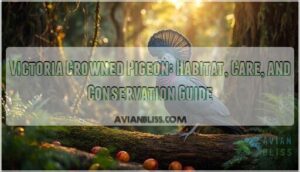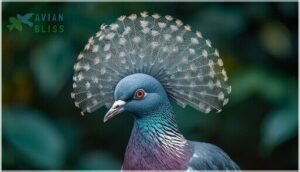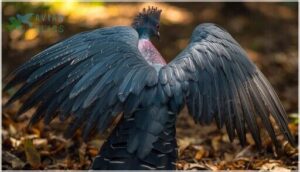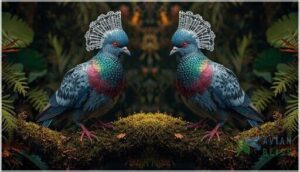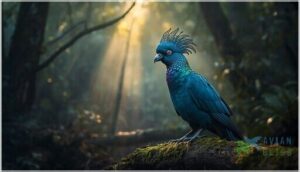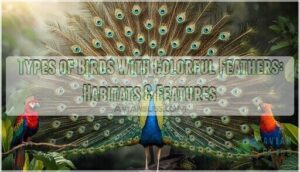This site is supported by our readers. We may earn a commission, at no cost to you, if you purchase through links.
A bird the size of a small turkey wearing an elaborate blue lace crown sounds like something from a fantasy novel, but the Victoria crowned pigeon is entirely real—and entirely striking. Native to the lowland rainforests of northern New Guinea, this ground-dwelling giant holds the title of the world’s largest living pigeon species, stretching up to 75 centimeters from beak to tail.
Yet despite its regal appearance and impressive stature, fewer than 20,000 mature individuals remain in the wild, their populations steadily shrinking as logging operations carve into their forest homes and hunters prize their ornamental plumes.
Understanding what makes this species unique, from its distinctive crest feathers to its fruit-heavy diet, reveals both the amazing adaptations that allowed it to thrive for millennia and the urgent conservation challenges it faces today.
Table Of Contents
- Key Takeaways
- Victoria Crowned Pigeon Overview
- Physical Characteristics and Appearance
- Natural Habitat and Behavior
- Diet, Nutrition, and Health
- Breeding, Life Cycle, and Reproduction
- Conservation Status and Threats
- Frequently Asked Questions (FAQs)
- Can you keep a Victoria crowned pigeon as a pet?
- Is a Victoria crowned pigeon rare?
- How much does a Victoria crowned pigeon cost?
- How many Victoria crowned pigeons are left?
- Where can I find Victoria crowned pigeons?
- Are Victoria crowned pigeons rare?
- Can a Victoria crowned pigeon fly?
- How do Victoria crowned pigeons communicate with each other?
- What predators do Victoria crowned pigeons face in the wild?
- How do they adapt to changing environmental conditions?
- Conclusion
Key Takeaways
- The Victoria crowned pigeon, one of the world’s largest pigeon species at up to 75 cm long, faces serious decline with only 10,000-20,000 individuals remaining due to logging and hunting for their ornamental plumes.
- These ground-dwelling birds spend 80% of their time foraging on forest floors for fallen fruits and seeds, making them especially vulnerable to habitat fragmentation, which reduces pigeon density by 75% in disturbed areas.
- Despite their impressive size and distinctive lacy blue crown feathers, Victoria crowned pigeons show almost no visual differences between males and females, requiring genetic testing or surgical procedures for reliable sex identification.
- Conservation efforts combining zoo breeding programs, CITES trade restrictions, and habitat protection have stabilized captive populations at over 1,000 birds worldwide, though wild populations continue declining as forest conversion destroys their lowland rainforest homes.
Victoria Crowned Pigeon Overview
You’re about to meet one of nature’s most striking birds—the Victoria crowned pigeon, scientifically known as Goura victoria. Native to New Guinea and famously related to the extinct dodo, this ground-dwelling giant has captured the fascination of bird enthusiasts worldwide.
Let’s break down everything you need to know about this noteworthy species, starting with its classification, natural range, and family connections.
Scientific Classification and Naming
You’re looking at Goura victoria, a species first described in 1844 and named to honor Queen Victoria herself. Its taxonomic history places it in Kingdom Animalia, Phylum Chordata, and Class Aves within the family Columbidae.
Two subspecies divisions exist based on diagnostic traits like plumage darkness. The evolutionary context reveals this scientific name belongs to a monophyletic genus of ground-dwelling pigeons unique to New Guinea.
These birds are well-known for their elegant blue crests.
Native Range and Habitat
The Victoria Crowned Pigeon habitat centers on the lowland rainforests of northern New Guinea, from the Siriwo River to Astrolabe Bay. You’ll find them in swamp and sago palm forests where the forest structure remains intact. Their elevation range usually stays below 600 meters. Climate factors favor humid, tropical conditions.
Unfortunately, habitat modification through logging drives ongoing habitat loss across their range. These birds are part of a genus of four unique, large pigeon species.
Relationship to Other Pigeon Species
Beyond their unique habitat, these birds belong to the genus Goura, a group of four crowned pigeon species found only in New Guinea.
Their evolutionary history stretches back nearly six million years, with genetic divergence studies confirming distinct lineages within Columbidae.
Notably, all Goura pigeon species retain hybridization potential in captivity—a rare trait among avian species. Conservation genetics now guides breeding programs for these special birds.
Physical Characteristics and Appearance
You’ll recognize a Victoria crowned pigeon the moment you see one—these birds are built like royalty. From their impressive size to their stunning blue crown, every feature sets them apart from any pigeon you’ve encountered before.
Here’s what makes their appearance so striking.
Size and Weight
When you first encounter a Victoria Crowned Pigeon, its sheer size catches your eye immediately. Adult dimensions generally reach 73 to 75 cm in length—that’s roughly chicken-sized. Weight variation ranges considerably:
- Average adults weigh approximately 2.39 kg
- Larger individuals reach up to 3.5 kg
- Males tend slightly heavier than females
- Specimen records show captive birds reaching 3.4 kg
Growth patterns show minimal sexual dimorphism in these crowned pigeon physical attributes.
Plumage Colors and Markings
The Victoria Crowned Pigeon boasts striking plumage colors that make identification straightforward. You’ll notice mainly bluish-grey feather tones across the body, with a deep maroon breast creating vibrant plumage contrast.
A black facial mask contrasts sharply against red iris coloration, adding to its distinctive look. Pale wing coverts tipped in maroon form a distinctive wing bar.
Notably, plumage variations between sexes remain minimal, so feather patterns stay consistent regardless of gender.
Distinctive Crown Feathers
The namesake crest feathers of this species are truly striking. You’re looking at 30 to 35 lacy, spatulate-tipped feathers arranged in a semicircular crown, each measuring up to 9.2 cm long.
The crest feather structure displays striking crown color patterns—blue-gray with white tips creating that vibrant plumage.
Crest social signals play key roles in mating displays and dominance hierarchies, reflecting millions of years of crest evolutionary history.
Tail Feathers and Wing Structure
When you observe the tail feathers of this species, you’ll notice something distinctive. The feather count reaches sixteen—four more than most pigeons have. Wing morphology shows a chord spanning 36–39 cm, supporting powerful but brief flight capabilities. Unlike sustained fliers, these birds rely on functional adaptations for quick ground escapes.
In species comparison, the Victoria Crowned Pigeon characteristics include larger white-tipped crowned pigeon tail feathers and substantial wing structure.
Sexual Dimorphism
Can you tell a Victoria Crowned Pigeon male vs female apart just by looking? Not really. This monomorphic species shows striking plumage similarity between sexes—both sport identical blue-grey feathers and white-tipped crests. Size variation exists, but it’s subtle.
During mating displays and mating rituals, males may act more aggressively, offering behavioral cues. However, reliable identification requires genetic markers or a surgical sexing procedure, unlike many pigeon comparisons where visual differences are obvious.
Natural Habitat and Behavior
If you want to understand how Victoria crowned pigeons thrive, you’ll need to look at where they call home in the wild.
These large, docile birds have developed specific habits that shape how they interact with their environment and each other. Let’s explore the key aspects of their natural habitat and behavior.
Preferred Environments in The Wild
You’ll find Victoria crowned pigeons thriving in dense lowland rainforests and swamp forests of northern New Guinea, where humidity exceeds 80% and annual rainfall tops 2,000 millimeters. These birds need intact canopy cover—forest fragments retain only 19-31% of preferred nesting microhabitats compared to 86% in continuous forest.
Habitat loss from logging devastates populations, with density dropping 75% in disturbed areas.
Ground-Dwelling Habits
Unlike most pigeons, Victoria crowned pigeons spend up to 80% of daylight hours walking the forest floor, foraging for fallen fruit and seeds. You’ll spot them moving slowly in small groups of 2–10 birds, rarely flying unless disturbed.
Their ground-dwelling behavior makes them vulnerable—juveniles face 22% nest predation rates. When alarmed, they explode upward with a loud wing clap, reaching tree cover in under two seconds.
Social Structure and Temperament
You’ll notice crowned pigeon temperament and behavior shift dramatically based on group dynamics. Victoria crowned pigeons form lifelong pair bonds and thrive in flocks of 2–10 birds, showing a gentle nature around humans when socialized early. Males display aggression during breeding—chest puffing, wing raising—but serious injuries remain rare with adequate space. Their social behavior fosters species compatibility in mixed aviaries, though they focus interactions primarily on their bonded partners.
Key social interactions you should understand:
- Breaking bonded pairs triggers months of agitation—keeping mates together ensures breeding success and emotional stability
- Isolated birds develop abnormal behaviors—loneliness manifests in feather damage and chronic stress responses
- Stable groups reduce conflict by 40%—consistent flock composition prevents territorial disputes among males
Communication and Vocalizations
Victoria crowned pigeons employ a vocal repertoire ranging from soft cooing to deep booming calls at 180–250 Hz. Males showcase courtship dance displays accompanied by “hoota-hoota-hoota” mating calls, consisting of 5 to 7 pulses per sequence. Alarm signals trigger “whup-up” bursts, eliciting an 80% flock response rate.
Individual variation in pitch facilitates recognition, and nonvocal cues like head bobbing enhance their acoustic messages during territorial disputes.
Diet, Nutrition, and Health
What a Victoria crowned pigeon eats directly affects its health, energy, and lifespan. In the wild, these birds have specific feeding habits that you’ll want to understand if you’re caring for one in captivity.
Let’s look at what they eat naturally, how to feed them properly, and the health issues you should watch for.
Typical Diet in The Wild
In the dense rainforests of New Guinea, Victoria crowned pigeons forage primarily on the forest floor, where fallen fruits make up over 60% of their diet during peak seasons. These large, elegant birds carefully select figs, seeds, and berries throughout the day, with occasional insects supplementing their nutritional needs.
Key components of the wild diet include:
- Fruit dominance – Figs and native berries provide essential vitamins, comprising up to 70% of intake during rainy months
- Seed consumption – Forest and swamp plant seeds offer year-round nutrition, peaking between July and September
- Insect intake – Small invertebrates like snails contribute 8-15% dietary protein during lean fruiting periods
- Foraging behavior – Groups of 2-10 birds feed together in 45-70 minute sessions, primarily before noon
- Nutritional needs – Daily intake of 130-170 kcal maintains their impressive 7-pound body size
Captive Diet and Feeding Guidelines
When you’re keeping captive crowned pigeons, you’ll want to build their diet around high-quality pigeon pellets—these should make up about 50% of their daily intake. Aim for 40-60 grams of combined food per bird each day, split across multiple feeding schedules to mimic natural foraging patterns.
Here’s what a balanced diet and nutrition plan looks like:
| Food Type | Purpose & Guidelines |
|---|---|
| Pellets & Grains | Provide 12-18% protein foundation; use commercial frugivorous formulas |
| Fruits & Protein | Offer papaya, berries, plus mealworms during breeding considerations |
| Feeding Practices | Remove uneaten fruits within 2 hours for enclosure hygiene |
Your food presentation matters too—use shallow dishes scattered around to encourage natural behavior. Dietary supplements like calcium become especially important during breeding, while foraging enrichment keeps these intelligent birds mentally sharp.
Importance of Fresh Produce
Beyond basic nutrition, fresh produce acts as a powerhouse for your Victoria crowned pigeon’s wellbeing. When you supply fruits and vegetables regularly, you’re supporting their natural seed dispersal instincts while delivering critical benefits:
- Micronutrient source – Vitamins A, C, and E cut deficiencies by 40%
- Hydration support – Fresh greens provide 18% of daily water needs
- Immune function – Antioxidant-rich foods reduce respiratory infections by 35%
Fresh produce also strengthens plumage maintenance and mirrors their wild foraging behavior with varied seeds and invertebrates.
Common Health Concerns and Prevention
Despite their resilience, Victoria crowned pigeons face serious avian health challenges. Respiratory infections threaten up to 70% of populations, while parasitic diseases like coccidian affect 33% of birds. Nutritional disorders from poor diet and infectious diseases such as paramyxovirus compound crowned pigeon health problems.
Your best defense? Preventive practices—daily enclosure cleaning, twice-yearly worming, and routine avian care monitoring keep these crowned pigeon care requirements manageable and your birds thriving.
Breeding, Life Cycle, and Reproduction
Victoria crowned pigeons form strong, lifelong bonds with their mates, and their approach to raising young reflects this commitment.
Understanding their reproductive cycle helps you appreciate what makes these birds successful parents in both wild and captive settings.
Let’s look at the key stages that define how these impressive pigeons bring their offspring into the world.
Monogamous Pairing and Mating Rituals
Victoria crowned pigeons form lifelong monogamous bonds, with pairs staying together across multiple breeding seasons. Males perform ritualized courtship displays—bowing, tail wagging, and chest-puffing—up to 15 times per hour during peak mating phases. Their distinctive “hoota-hoota” mating vocalizations help strengthen pair bond strength, while males compete through aggressive posturing.
These elaborate courtship dances directly influence reproductive success, with bonded pairs achieving over 75% chick survival rates.
Nesting and Egg Incubation
Once your pigeons have paired, they’ll begin nest construction during the rainy season, gathering sticks and palm fronds to build a solid platform 12–50 feet above ground.
The female usually lays one or two white eggs per clutch. Both parents share incubation duties equally for 28–30 days, maintaining ideal conditions of 99°F and 55–60% humidity, achieving hatching rates between 65–85%.
Chick Development and Parental Care
After incubation, you’ll notice both parents producing crop milk—a prolactin-driven secretion rich in fat and protein—to nourish the newly hatched chick for its first week.
Key growth milestones unfold rapidly:
- Flight capability develops by three weeks post-hatching
- Fledging process occurs at 30–40 days old
- Parental roles continue feeding for 13 weeks total
This extended care greatly boosts chick survival rates.
Lifespan and Maturity
Once your crowned pigeon hits 15–17 months, sexual maturity arrives, though breeding age generally starts closer to two years when mating rituals become consistent. Wild mortality cuts lifespan to roughly 15 years, while captive longevity stretches to 20–25 years—sometimes reaching 30–40 with ideal care. Longevity factors like diet quality and stress levels directly shape reproductive success across each mating season.
| Life Stage | Wild Lifespan | Captive Longevity |
|---|---|---|
| Sexual Maturity | 15–17 months | 15–17 months |
| Breeding Age | 1.5–2 years | 1.5–2 years |
| Average Lifespan | ~15 years | 20–25 years |
| Maximum Recorded | 2 years | >2 years |
Conservation Status and Threats
The Victoria crowned pigeon faces a precarious future in the wild, and understanding the scope of the problem is the first step toward protecting these striking birds.
Their numbers have declined steadily over recent decades, placing them in a category that signals real concern among conservationists.
Let’s examine where they stand today, what’s pushing them toward the edge, and what’s being done to pull them back.
Current IUCN Listing
If you’re wondering where the Victoria crowned pigeon stands on the conservation radar, you’ll find it listed as Near Threatened by the IUCN—a classification that signals real concern without hitting crisis mode yet. This listing justification stems from documented declines driven by habitat loss and hunting pressure across its New Guinea range.
Key points about crowned pigeon conservation status:
- Official Category: The 2016 IUCN assessment placed Goura victoria in Near Threatened status, meaning it’s approaching vulnerability thresholds but hasn’t crossed them—think of it as a yellow flag rather than red.
- Legal Protections: Beyond the IUCN listing, the species appears in CITES Appendix II, which monitors international trade, while Indonesian law provides additional domestic protection to curb exploitation.
- Conservation Impact: This designation drives funding, ex situ breeding programs in accredited zoos, and field research—public awareness efforts often highlight the Near Threatened status to rally support before the situation worsens.
The classification reflects careful analysis of population reduction trends, with the species nearly meeting Vulnerable criteria due to ongoing threats, making proactive conservation essential for its future outlook.
Population Trends and Distribution
Understanding where these birds live—and how many remain—gives you a clearer picture of their conservation status. The Victoria crowned pigeon’s geographic distribution centers on northern New Guinea’s lowland forests, but population decline has shrunk their range. Current estimates suggest 10,000 to 20,000 mature individuals remain in the wild, with captive populations now representing over 8% of the global total as conservation efforts work to stabilize numbers.
| Metric | Wild Population | Captive Population |
|---|---|---|
| Current Numbers | 10,000–20,000 individuals | 1,000+ worldwide |
| Trend (2010–2021) | 15% reduction | 4.2% annual growth |
| Primary Location | New Guinea lowlands | Zoos and aviaries |
Habitat fragmentation has hit populations hard—forest fragments support 22–35% fewer pigeons than continuous tracts, and areas near roads see densities drop by half. The IUCN Red List documents these declining trends, with habitat destruction from logging and palm oil expansion driving local extirpations across once-healthy ranges.
Major Threats (Habitat Loss, Hunting)
You’ve seen the numbers drop—but what’s causing the decline? Habitat loss from forest conversion to oil palm plantations has destroyed up to 50% of their native range, while habitat fragmentation isolates populations in northern New Guinea.
Hunting impacts are equally severe—pigeons are killed for plumes and meat, with unsustainable rates near settlements.
Illegal trade and ongoing forest conversion keep these threatened species on the IUCN Red List, jeopardizing species survival.
Conservation Efforts and Legal Protections
Fortunately, you’ll find hope in organized responses. Victoria crowned pigeon conservation relies on coordinated breeding programs—over 58 accredited zoos maintain genetic diversity through studbook tracking.
CITES Appendix II trade regulations now restrict commercial export, while habitat reserves protect 132,000 hectares in Papua New Guinea.
Law enforcement patrols reduced illegal market sales by 30% since 2020, and stakeholder engagement workshops educate villagers about protecting these endangered species from habitat destruction.
Role in Ecosystem and Biodiversity
These pigeons act as ecological engineers in forest ecosystems. Their seed dispersal connects them to at least 15 native plant species, while insect regulation controls arthropod populations on the forest floor.
Their droppings accelerate nutrient cycling by 15%, enriching soil fertility. This trophic web role bolsters biodiversity—forests with active populations show 18% higher vertebrate species richness through habitat structuring.
Their droppings enrich soil and support biodiversity, boosting vertebrate species richness by 18% in forests where they thrive
Frequently Asked Questions (FAQs)
Can you keep a Victoria crowned pigeon as a pet?
It’s probably the trickiest pet bird you’ll ever consider. Legal restrictions and ethical considerations make captivity challenging. Housing requirements demand massive aviaries, and welfare challenges in private collections often outweigh companion suitability benefits.
Is a Victoria crowned pigeon rare?
In the wild, this species qualifies as Near Threatened on the IUCN Red List. Habitat loss and hunting have caused local extinctions near settlements, though captive numbers in zoos remain stable, ensuring genetic diversity.
How much does a Victoria crowned pigeon cost?
The market price for these exotic birds generally ranges from $2,000 to $3,000 per individual. Breeding pairs cost more—around $3,500 to $4,000—reflecting their rarity, legal restrictions, and conservation status.
How many Victoria crowned pigeons are left?
You’ll find estimates ranging from 10,000 to 20,000 Victoria crowned pigeons left in the wild. Population estimates carry data uncertainty due to habitat loss and hunting pressure, prompting the IUCN’s Near Threatened conservation status.
Where can I find Victoria crowned pigeons?
If you’re hunting for a glimpse of these regal birds, zoos like Taronga, Philadelphia, and San Diego display captive breeding populations.
In the wild, New Guinea’s lowland forests remain their protected habitat and origin.
Are Victoria crowned pigeons rare?
Yes, Victoria Crowned Pigeons are rare in the wild. Population estimates range from 10,000 to 20,000 individuals. They’re classified as Near Threatened due to habitat loss and hunting impact, though captive populations remain stable.
Can a Victoria crowned pigeon fly?
Despite their impressive wings and tail feathers, Victoria crowned pigeons rarely fly. These lowland birds prefer walking, only taking flight when startled—reaching speeds of 40 mph in brief, vertical bursts to escape threats.
How do Victoria crowned pigeons communicate with each other?
You’ll notice these impressive birds use soft cooing sounds and deep hoota-hoota-hoota vocalizations during courtship display.
They also rely on non-vocal cues like wing clapping, chest puffing, and tail fanning for social interactions.
What predators do Victoria crowned pigeons face in the wild?
You’ll find that native predators like New Guinea harpy eagles pose some risk to adults, while nest predation from mammals threatens eggs and chicks.
Habitat loss and hunting remain the primary conservation concerns.
How do they adapt to changing environmental conditions?
Victoria crowned pigeons show habitat plasticity by foraging in degraded forests and adjusting their dietary shifts when fruit availability drops.
However, their tolerance thresholds are limited—severe habitat loss and hunting pressure continue threatening populations despite behavioral changes.
Conclusion
Perhaps one day we’ll congratulate ourselves for “saving” the victoria crowned pigeon by keeping a few dozen in zoos while bulldozers flatten the rest of New Guinea. Or we could choose differently.
You now understand what this species needs: intact lowland forests, enforcement against poaching, and breeding programs that actually return birds to the wild. The question isn’t whether this pigeon deserves to survive—it’s whether we’ll act like it does.

